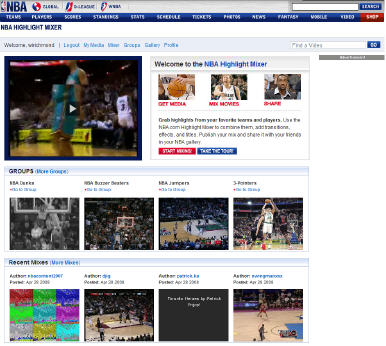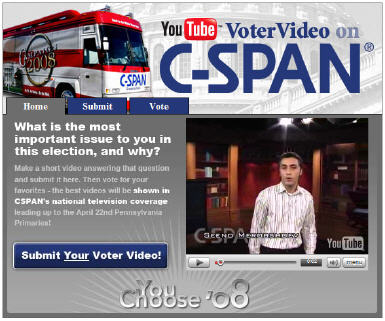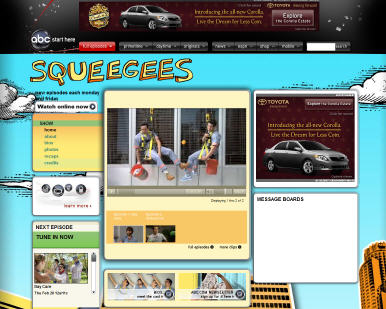-
Eyespot Shifts Focus to Network Model and Mid-Tail Video Providers
Another sign of how quickly broadband video companies are adapting themselves to market conditions: Eyespot, which started by providing video editing capabilities to users of big branded web sites has evolved its focus to a network model, specializing in mid-tail sized video providers. CEO/co-founder Jim Kaskade explained their shift to me and why it's paying off.
Eyespot's core capability remains providing video editing and sharing tools, but it is now also offering them in a self-serve model, enabling small-to-mid sized sites to quickly get up and running. Jim sees at least 2 clear differentiators for Eyespot:
First, for sites which want to offer a user-contributed video capability, Eyespot addresses all the complexities such as handling multiple file formats, offering strong moderation and monetization. ExpertVillage is a good example of a site benefiting from this approach. EP's myriad "experts" contribute their how-to videos to the site using Eyespot's tools. In this model, Eyespot is fundamental video infrastructure, powering all of the video publishing at the site.
Depending on the business model the provider chooses for the user-contributed capability, all of their video can be included for syndication to other sites by Eyespot to others in the network. This includes options for delivery to mobile devices. Eyespot monetizes the network, currently at $4-8 CPM. In addition to powering user contributions, this capability is also appealing for mid-tail providers who just intend to upload and manage their own video.
A second differentiator, for providers who don't necessarily want to allow user uploads, is Eyespot's core video studio. In this offering, content providers offer their own library of media assets for users to mix and publish. NBA.com is an example of this implementation. When you go to NBA.com, in the video tab, there's an option for "NBA Highlight Mixer," where the user will find media that NBA has offered for mixing. A gallery of users' mixes is displayed, along with tools to share and embed your mixes. In this example, Eyespot augments the NBA's other video initiatives powered by Akamai's StreamOS.
Jim explained that the payoff from offering video personalization is in driving more video views and hence more ad revenue. Jim explained that a typical site might get 10 video views per unique visitor per month, while Eyespot-powered sites get around 80.
I've been bullish for a while about the potential of user contributions and editing, yet it seemed like the market was slow to catch on. With Eyespot's new approach making access to its tools much easier, this will hopefully accelerate adoption.
Categories: Technology, UGC
Topics: ExpertVillage, Eyespot, NBA
-
YouTube, C-SPAN Team Up for User-Generated, Multi-Platform Voter Project
Broadband video's influence on Election Year 2008 grew further with today's announcement of the "YouTube Voter Video on C-SPAN" initiative.
To build momentum toward the Pennsylvania primaries on April 22nd, the companies are inviting viewers to upload to the C-SPAN channel on YouTube videos answering the questions "what issue in this election is most important to you, and why?" C-SPAN will air a selection of the videos on its "Road to the White House" program beginning April 13th.
I think this is a clever, fun idea to help drive awareness and share disparate views on the election. Though participation is completely self-selected, it will certainly offer much-needed dimension to the dry polling results constantly churning through the media. Combined with the CNN/YouTube debates from a couple months ago, Election Year 2008 continues to show how much more dynamic and inclusive the process becomes with broadband video's influence.
-
3 Broadband Video Snippets to End the Week
Closing out another busy week, here are 3 diverse broadband video snippets that hit my radar in the past few days:
1. YouTube Drives the Political Newscycle
Back in December, in 6 Predictions for 2008, I suggested that "2008 is the year of the broadband presidential election." This seems to become more evident with each passing week. I find that particularly when watching cable news, YouTube's influence just keeps on growing.
For example, I'm a fan of "AC360" on CNN, which I try to catch at 10pm each night. This week the show was constantly replaying the YouTube videos of Rev. Jeremiah Wright that have dogged the Obama campaign. Conversely, a few weeks ago, Obama got a great tailwind from the massive attention paid to the viral "Yes We Can" music video sensation by will.i.am. That of course was on top of the earlier "Obama Girl" phenomenon. Separately, the McCain campaign just yesterday fired a campaign worker for posting a controversial video on YouTube about Obama and race. This too was covered on AC360 last night. Then of course there were the YouTube co-sponsored debates, offering video-based questions that were constantly replayed afterward.
The point of all this is that broadband video has turned election coverage upside down, making it incredibly hard for candidates to control the political newscycle. The "democratizing" effect of YouTube means that on any given day, at any given moment, something may get posted which diverts the campaign's attention. And with major media outlets paying such close attention to YouTube, everything is immediately amplified. Not since the early 1960s when TV began influencing presidential politics have we seen a new medium have such a profound impact on an election. And we still have 8 months to go until November...who knows what's yet to come!
2. SI Vault is Addictive
On to something more fun, if you haven't yet checked out Sports Illustrated's new "SI Vault" site just launched this week, I suggest you do. It's a highly addictive trip down memory lane. SI has digitized all of its assets and also made available non-SI content, all in one easy-to-use location powered by Truveo. Focusing on video, I found Franco Harris's "Immaculate Reception" from the 1972 Steelers-Raiders playoff game and also Doug Flutie's famous "Hail Mary" pass to beat Miami in 1984. I could have spent hours at the site, although it's not perfect. I tried finding Tom Watson's 1982 U.S. Open chip-in at Pebble Beach to beat Jack Nicklaus, but alas no results were found. Obviously all this stuff is available elsewhere online, but SI Vault creates a great context for sports fans to enjoy themselves, wrapping SI and non-SI content together in one nice package.
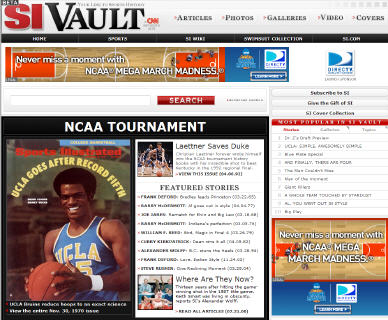
3. Apple's Roadblocks are Baaaack
And for even more fun, I encourage you to check out WSJ.com and NYTimes.com today. Apple is "roadblocking" the home pages of both again with a new Mac vs. PC ad, as they did back on Jan. 17th. This means that Apple has bought out all the home page leaderboard inventory on these 2 sites, so every time a visitor comes today, they see the same Apple ad. With all the talk about broadband video advertising, pre-rolls, overlays, etc, Apple again shows with its roadblocks how a little bit of creativity with rich media ad units can go a really long way. The ads are a great mix of interruption and opt-in and are no doubt highly effective branding units for Apple. Have a look and enjoy.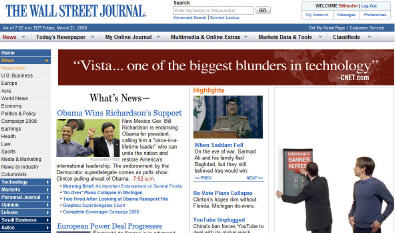
Categories: Brand Marketing, Cable Networks, Politics, Predictions, Sports, UGC, Video Sharing
Topics: Apple, Barack Obama, CNN, NYTimes.com, Sports Illustrated, Truveo, WSJ.com
-
My 3 Takeaways from 2008 Media Summit
I had 3 key takeaways from the 2008 Media Summit which just wrapped up in NYC. The event just keeps getting better - great keynotes, terrific informal hallway chit-chats/networking and tons of well-directed energy. Though the event's agenda is broad, I was focused on the video-related elements. Here are 3 takeaways:
1. Iger and Moonves Get Tech; Lots of Innovation/Growth Ahead
A clear highlight for all attendees was the 2 morning keynote interviews, day 1 with Disney CEO Bob Iger and day 2 with CBS CEO Leslie Moonves. Both were ably conducted by senior Businessweek editors. Until a couple years ago, big media was in a defensive crouch regarding technology's uninvited incursion into their businesses. No more. Iger and Moonves are obviously convinced that technology, the Internet and broadband video delivery are now their companies' friends. Iger in particular really pounded this theme home.
An example of how technology helps which Iger repeatedly touched on was how Disney will leverage the platform of Club Penguin, its recent acquisition, to build communities for other properties (e.g. "Cars", "Pirates," etc.). These moves are intended to engender ever-greater levels of engagement. By the way, if you're a parent of youngsters and you've ever bemoaned how Disney's gotten its hooks deeply into your kids, you ain't seen nothing yet!
Moonves was emphatic that the Internet extends the value of CBS properties. March Madness was an example he offered. Three years ago it generated $250K of broadband subscription revenue. Two years ago CBS converted to ad-support and generated $4M. Then last year it generated $10M and this year is projected for $23M. And as Moonves pointed out, other than bandwidth, it's all incremental profit for the company. Echoing another conference theme, he further added that "the Internet should not be used to just regurgitate TV," but rather for the medium's unique capabilities.
Iger's and Moonves's mantras are no doubt being sent down to the troops from the executive suite. That suggests we can all expect a whole lot of tech-based innovation springing from these media giants.
2. Engagement and Originality: Buzzwords or More?
Two touchstones in many sessions were "engagement" and "originality." Both reflect the evolving viewpoint that broadband video has its own unique capabilities and that breaking through requires going far beyond traditional, passive programming approaches. With respect to engagement, the concept of introducing "social media" opportunities was often cited as the key tactic. An amorphous term, social media refers to all manner of user participation: content sharing, interactivity, personalization, mashups, uploading, commenting, rating and so on. Basically it's anything that gets viewers to do more than just sit back and enjoy the show. (For those looking to learn more, note next week's webinar on social media, presented by VideoNuze sponsors KickApps and Akamai)
Regarding originality, this relates back to Moonves's comment about not using the medium for regurgitation of TV shows (though to be sure there's value to that). Many people echoed that theme, emphasizing broadband must be used for original programming. The proliferation of independent "broadband studios" is encouraging early evidence that the originality bar will keep rising, prompting established and startup players to harness broadband's limitless possibilities.
3. Missing in Action: Paid business models
It wasn't that long ago that discussions about broadband video business models focused evenly on paid and ad-supported. No more. The paid model was completely missing in action at the event. I think I can count on one hand the number of times the concept was raised in sessions. Also MIA was DRM, the paid model's enabler (or torturer, depending on your perspective).
I detect a broad consensus that the broadband video industry has hitched its wagon to free ad-supported video for the foreseeable future. Many of you know I've been a long-time and enthusiastic proponent of this approach and I'm extremely happy to see things unfold this way. Though the broadband video ad model is still immature, all macro trends point to a bright future. One in particular is video syndication, which I wrote about 2 days ago. Syndication was a dominant theme, as panel representatives from both large and small content providers enthusiastically embraced it. See my post earlier this week, "Welcome to the Syndicated Video Economy" for more on this.
Ok, there you have it. There's plenty more tidbits I took away from the summit, so feel free to ping me if you'd like. And if you attended, post a comment and share your takeaways as well!
Categories: Advertising, Broadcasters, Downloads, Syndicated Video Economy, UGC, Video Sharing
Topics: Akamai, CBS, Disney, KickApps
-
UGC and Brand Marketing, Part 2
Wrapping up the week, today I revisit a post from several weeks ago, "An Intersection of UGC and Brand Marketing?"
In that post I mused about the opportunity for brand marketers to harness the recent enthusiasm many consumers have for creating video, as evidenced by the popularity of sites like YouTube. The idea I floated concerned how brands might somehow incent consumers to produce informative videos about their favorite products, which in turn could be showcased by the brands to help prospective buyers were in research mode. It seemed to me there might be a happy marriage in there somewhere.
It turns out I may have had my head in the clouds on this one. Daphne Kwon, CEO of ExpoTV reached out to me to explain some of the realities that my idea would encounter. Daphne's in a good position to know, since ExpoTV runs a site offering users the opportunity to upload videos with their reviews/opinions about products. ExpoTV has aggregated over 200K of these "Videopinions" to date. ExpoTV isn't exactly the concept I had in mind to marry UGC and brands, but it's definitely in the same ballpark.
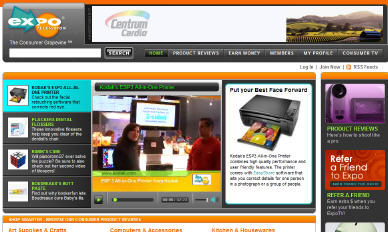
Daphne raised two issues which she believes constrains brands from pursuing the user-generated reviews idea I envision. First is the specter that these reviews will be biased in some way. There are multiple dimensions to this. Will the brand maintain a completely open environment so that even negative reviews would be posted? If so, what are the implications? If not, and only positive videos are exposed, then the area wouldn't feel authentic or trustworthy. Also, would reviewers bias toward saying positive things simply to ingratiate themselves with the brand for ulterior reasons, such as getting noticed to be in a future ad or obtain funding for a private project?
Further complicating this is Daphne's sense that when people upload videos they're doing so to be part of a community that is responsive and interactive. This has clearly been a big part of YouTube's success. So brands couldn't just offer a place to upload, but rather would need to hire staff to manage the area, interact with participants, figure out how the area should be policed or self-policed, etc. Daphne doesn't see brands biting all off all of this, as it's a lot of work and she doesn't see any corporate mandates for brands to actively participate in these kinds of community-building activities.
Second and possibly more problematic is that there may be legal liability for brands to provide such platform, as the brands might be held responsible for the truthfulness and accuracy of the user-submitted videos. This liability would be broad, ranging from the relatively small (e.g. "The product didn't work as explained") to the very significant (e.g. "I used the product this way and was injured."). Clearly, in the litigious society in which we live, deep-pocketed corporations could be exposing themselves to all kinds of financial risks. Then of course there is the risk of negative PR, which alone could be quite damaging. Tying back to issues above, if there isn't a clear mandate to pursue these activities, no astute corporate soldier is going to risk his/her career diving into such precarious waters.
Hearing these considerations makes me think that the optimal route for incenting user-created video reviews may just be the way ExpoTV is doing it. Provide a "well-lit" space with a mix of financial incentives and community recognition, and monetize traffic in a number of creative ways (affiliate deals, advertising, etc.). Importantly maintain a focus on the community-building tasks required for motivating active and continuous user participation.
All of this serves as another reminder that with broadband - as with technology in general - just because something is possible, doesn't necessarily make it advisable.
What do you think? Post a comment and let us all know!
Categories: Brand Marketing, UGC
Topics: ExpoTV
-
Disney/ABC's Stage 9 Launches, With YouTube
Disney/ABC Television Group's official announcement this morning of Stage 9 Digital Media, an experimental new media content studio, is another key milestone in the fast-moving broadband video industry.
I got a short briefing about Stage 9 late yesterday from Disney/ABC because it asked me to provide some analyst context to the LA Times' Dawn Chmielewski, who's done a great piece here. Stage 9 is Disney/ABC's key initiative to reach the coveted 18-34 audience in synch with this audience's unique media consumption patterns. Programming will be short, funny, well-produced, episodic, and widely distributed through popular broadband sites, social networks, mobile and download services.
I interpret Disney/ABC's move, when coupled with recent initiatives by other big media companies into original broadband video production, as further evidence of two key trends: that broadband video has come of age as a key priority for the largest media companies and that it is impossible to appeal to today's younger audiences simply by hewing to the traditional rules of the media game.
Also of significance is that Disney/ABC announced that "Squeegees," which is Stage 9's first release, will be co-exclusively premiered on ABC.com and YouTube starting today and sponsored by Toyota. Yes, you read that right. YouTube! The scruffy user-generated phenom that big media was threatening to sue out existence not so long ago, and which of course is now owned by Google, big media's most anxiety-inducing "frenemy," has been elevated to launch partner status for Stage 9's first program.
The "Squeegees" co-premiere is quite an accomplishment for YouTube. It shows that YouTube's methodical efforts to gain legitimacy (and a business model!) by establishing partner channels with media companies are beginning to pay off. David Eun, Google's VP of Content Partnerships has repeatedly explained this game plan to me, and others over the last year. The Stage 9 launch partnership should certainly be regarded as a major win for the young company. It is also another data point I'd use to support my contention that in the broadband age, traditional conceptions about copyright monetization need to be radically re-thought (Viacom, are you listening?).
I'm enthusiastic about the Stage 9 initiative, as I believe it holds lots of potential for Disney/ABC. It gives the company inroads to the elusive 18-34 set, offers the prospect of innumerable and invaluable insights about how to effectively program in the broadband age, provides a whole new internal breeding ground for developing new on-air programming (a possible double win, as this might help fix the broken and expensive traditional pilot process, though my enthusiasm on this point is tempered by news today of Quarterlife's NBC ratings fiasco) and creates new and exciting multi-platform sponsorship opportunities.
In short, the strategy is sound and the upside significant. Now for the hard part: Stage 9 needs to execute and actually deliver on all this potential.
What do you think? Post a comment now!
Categories: Broadcasters, Indie Video, UGC
Topics: ABC, Disney, Stage 9, Toyota, Viacom, YouTube
-
And the Oscar Goes To.....Dove
Obviously there is no Oscar category for "Most Effective Advertisement at Oscar.com," but if there were, the hands-down winner last night would have been Unilever's "Dove Supreme Cream Oil Body Wash Ad Contest" display ads.

As many of you know, I'm a big believer that brand advertisers need to evolve their mindsets, which have traditionally called for making the cutest or the funniest or the quirkiest ad and then spending big money on placing it on popular programs, in the hopes of driving audience awareness and recall.
Instead, advertisers need to be focusing on user engagement, reinforcing brand authenticity, leveraging multiple platforms and extending the campaign's life. Dove did all of these and more with its "Cream Oil" campaign, and the resulting lessons for other brand marketers and their agencies are abundant.
Dove kicked the "Cream Oil" campaign off late last year, with a user-generated video contest asking women "how does showering yourself in everyday luxury with Dove Supreme Cream Oil Body Wash make you feel?" There were 3,500 entries received for the 30 second spot between Dec. 5th and Jan. 9th, which were winnowed to 5 semi-finalists on Jan 30th who were invited to LA for a private Oscars party. The 2 finalists were presented for viewing on Oscar.com. Dove's display ads on the site prompted visitors to click and vote for the best spot, which would become Dove's new ad. This voting process created an even larger user engagement opportunity than the original UGC contest. Capping it all off was actress Amy Brenneman, announcing the winning ad during a spot Dove bought during the Oscar telecast.
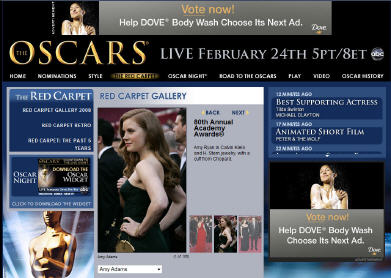
In my post last week, "An Intersection of UGC and Brand Marketing?" I proposed that brand marketers should create opportunities for passionate customers interested in expressing themselves to submit user-generated video supporting or explaining products. Dove's marketing people were clearly in synch with this thinking. The campaign shows their belief that the authenticity of the Cream Oil product could best be conveyed by real women using video to creatively express themselves. That sense of authenticity in turn resonates really well with other prospective customers. The YouTube age has conditioned many of us to appreciate each other's video more than the professionally produced, because its rough edges make it feel far more real.
Lastly, by having Ms. Brenneman announcing the winner in the on-air spot, Dove recognized that if it is going to spend $1.7 million + for a 30 second ad (last year's price), it better do more than just offer another cute, funny, or quirky spot. Instead it created anticipation, and capped off 3 months of contest excitement. I've argued in the past that these expensive on-air spots should reinforce or continue campaigns begun before and/or extended after in the broadband medium. Doing so increases their ROI, and will only raise the value of this on-air time in the future.
In the past I've been critical of brand marketers and their agencies for being abysmally slow in recognizing new opportunities broadband video presents. Yet there have been exceptions, and Dove's "Cream Oil" campaign is certainly one. Hopefully we'll see more like it in the future.
What do you think? Post a comment and let us all know!
Categories: Brand Marketing, UGC
-
An Intersection of UGC and Brand Marketing?
(Quick correction - there was a technical problem with the link in yesterday's email to register for the Feb. 28th webinar. The correct link to register is here).
Lately I've been thinking a lot about where there may be potential points of intersection between user-generated video and brand marketing.
On the one hand, YouTube and others have demonstrated there's huge interest among amateur producers in creating and posting video content. Since the overwhelming majority of these producers do not make any meaningful money from these videos, their motivation is emotional. On the other hand, brands are grappling with things like how to break through the clutter, deepen consumer engagement, create more authenticity and build loyalty.
So it seems like there should be a natural point of intersection if brands could incent their passionate customers to create videos which not only sang the praises of their favorite products but actually provided valuable information sought by other prospective customers. Offering these videos would enable customers to show off their favorite products in action and also provide a valuable service to prospects. The concept is sort of like a video-based TripAdvisor, but not limited to travel.
Here's an example from a personal experience. Recently I've been in the market for a 50+ inch HDTV. If you've been in this mode recently you know the drill - lots of online research, reading users' comments, going to stores to see different models, etc. Even after doing all this, I still felt like I was missing something. I really wanted to see the intangibles - what distance seemed right, what's the right height for the stand, what were the ambient issues, how were accessories connected and so on.
In short, I was looking for actual owners to provide short, but informative videos showcasing how the TV actually worked out when brought into their homes. To be sure, there's no shortage of text comments to this effect. But the best I could find beyond text was a link at Amazon to "Share your own customer images." It seems like such a natural to me that online retailers, review sites and TV manufacturers should all provide a user-generated video platform for consumers to upload videos providing further information on their TVs.
What I'm describing is not another brand-sponsored UGC contest, but rather solid consumer-contributed product information. T-Mobile has something like this running with Current TV right now, but seems to really be the exception. I looked at the web sites of Sony, Samsung, Panasonic, Sharp, Philips and Mitsubishi and, although in some cases there are buying guides and FAQs, none of them seek to harness the enthusiasm of their actual customers by enabling video contributions.
Maybe I'm missing something, but I think this is a big untapped opportunity. I know companies like ViTrue and StashCast are pursuing opportunities like this, and then there are countless private label social network platforms like KickApps, Ning and others (TechCrunch has a good list here) that also enable some flavor of this. But I just haven't seen this concept clearly or pervasively implemented yet. If you have, please post a comment. I just have to believe that some smart brands - particularly those selling complex, expensive products that benefit from video-based information - are going to realize their passionate customers are incredible assets just waiting to be empowered to speak out through user-generated video.
Categories: Brand Marketing, UGC
Topics: Amazon, Current TV, KickApps, Ning, Stashcast, T-Mobile, ViTrue
-
Branded Entertainment is Upon Us
If you had any doubts that brand marketing and entertainment programming are converging, an hour spent
 listening to a presentation at the NATPE conference yesterday by Shelly Lazarus, Chairman and CEO of Oglivy & Mather Worldwide would have quashed them in a hurry.
listening to a presentation at the NATPE conference yesterday by Shelly Lazarus, Chairman and CEO of Oglivy & Mather Worldwide would have quashed them in a hurry. This new reality is a direct result of the audience-fractured, advertising-averse world in which we now live. Ms. Lazarus believes that for agencies, "the challenge as stewards of brands is to help them tell a better story." In fact, telling a better story (the traditional agency imperative, I would argue) is no longer sufficient, as Ms. Lazarus continued: "Now brands need to be a part of the content story."
As such, she envisions far tighter links between ad agencies and the Hollywood creative community. Drawing a meaningful distinction about these industries' respective roles, she explained to the audience of content types: "We need all of you desperately...we can come up with a brand idea, but we can't do programming."

She emphasized repeatedly that to optimize the branded entertainment relationship, agencies and the advertisers they represent should not be called upon to "write a check" when production is virtually wrapped up. Rather, they should be brought in as early in the creative process as possible, and be provided an opportunity to help shape the story narrative and become a vital part of it.
Even while recognizing the role that brands have played since the early TV days of sponsored "soap operas", this proposed tight intertwining of advertising and programming will no doubt strike creative purists as heretical, while sending consumer protection advocates to DEFCON 5.
Regardless, the branded entertainment initiatives Oglivy is now encouraging its clients to selectively pursue reflects nothing more than the hard realities of today's complex and brutally competitive marketplace. Empowered by ever-stronger technologies - broadband chief among them - consumers are getting choosier in their media consumption habits, with advertisers and their messages getting the short end of the stick. With technology increasingly defining young people's lifestyles, this is a trend that will only intensify.
Faced with this daunting prospect, leaders in the agency world like Ms. Lazarus have astutely recognized that by carefully placing their clients' brands within the story line itself, they are creating a much-needed firewall, not to mention a breakthrough new consumer engagement opportunity. To be sure, branded entertainment is not a willy-nilly pursuit, at least not at Oglivy. The agency has set up a unit solely to create, execute and manage these opportunities. Listening to Ms. Lazarus, it was apparent that for all her enthusiasm for branded entertainment, she knows it's neither universally appropriate for all brands nor a catch-all cure to all that ails the industry.
Branded entertainment and broadband video are a perfect match in many respects. Broadband video's nascent development, combined with its still unclear monetization mechanisms and flexible/interactive capabilities make it fertile ground for agencies such as Oglivy to experiment.
So where specifically does all this lead? Three things I would bet on: more product-centric viral video initiatives like Dove's Evolution (presenting an opportunity for Dove - an Oglivy client - to "have a point of view about beauty," as Ms. Lazarus put it), more product sponsored and conceived programming (e.g. Hellmann's "In Search of Real Food" on Yahoo; Hellman's is another Oglivy client) and more user-generated video contests around products (e.g. Frito-Lay, Heinz, etc.).
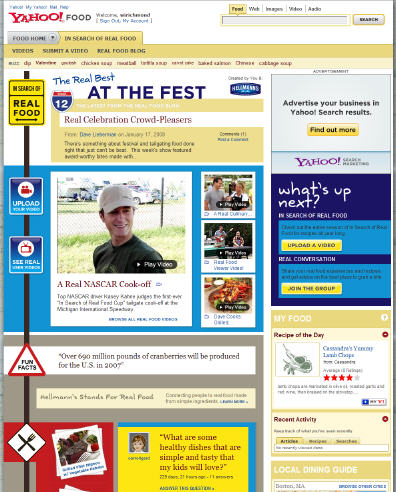
Broadband video is flowering just as traditional advertising and entertainment forms are under increasing duress. As such, it will be an enormous sandbox for agencies, brands, content creators and their audiences to all play in.
Categories: Brand Marketing, Indie Video, Strategy, UGC
Topics: Oglivy
-
CES 2008 Broadband Video-Related News Wrap-up
CES 2008 broadband video-related news wrap-up:
Panasonic and Comcast Announce Products With tru2way™ Technology
Panasonic And Comcast Debut AnyPlay™ Portable DVR
NETGEAR® Joins BitTorrent™ Device PartnersD-Link Joins BitTorrent™ Device Partners
Vudu Expand High Definition Content Available Through On-Demand Service
Sling Media Unveils Top-of-Line Slingbox PRO-HD
Open Internet Television: A Letter to the Consumer Electronics Industry
Paid downloads a thing of the past
Samsung, Vongo Partner To Offer Movie Downloads For P2 Portable Player
Comcast Interactive Media Launches Fancast.com
New Year Brings Hot New Shows and Longtime Favorites to FLO TV
P2Ps and ISPs team to tame file-sharing traffic
ClipBlast Releases OpenSocial API
Categories: Advertising, Aggregators, Broadband ISPs, Broadcasters, Cable Networks, Cable TV Operators, Devices, Downloads, FIlms, Games, HD, Mobile Video, P2P, Partnerships, Sports, Technology, UGC, Video Search, Video Sharing
Topics: ABC, BitTorrent, BT, Comcast, D-Link, Disney, Google, HP, Microsoft, NBC, Netgear, Panasonic, Samsung, Sony, TiVo, XBox, YouTube
-
Highlighting 3 Partnerships Announced at CES
Among the many partnership announcements at CES this week, there are a number worth highlighting. Today I focus on the following three:
Viacom syndication - Viacom announced syndication deals for MTV Networks' stable of content with five leading broadband video sites: Dailymotion, GoFish, Imeem, MeeVee and Veoh. As those of you who have been following my previous posts know, I believe syndication is a critical engine in driving the advertising business model, which itself is the key to broadband video succeeding. As a result, I follow these syndication deals closely.

I've previously been critical of MTVN which appeared reluctant about syndicating its content when it launched its DailyShow.com destination site. However, with its recent deal with AOL, and now these five deals, it appears that MTVN does in fact believe syndication is the way to go. As one of the biggest cable network groups, MTVN is a key barometer for other networks' moves, so I view this as a real positive for the market.
Panasonic/Google - In this deal, Google and Matsushita announced that YouTube videos and Picasa photos would be directly accessible on new model Panasonic HDTVs launching in Q2 '08. Ordinarily I wouldn't be
 too excited about a deal like this, a permutation of which we've seen with other TV makers such as Sony.
too excited about a deal like this, a permutation of which we've seen with other TV makers such as Sony. Yet this one rises in potential importance because YouTube is not just the most popular video site - with 40% of all video traffic - but because Google is determined to turn YouTube into a platform for legitimate content distribution. This was underscored by the Sony mini-sode deal also announced this week, and the
 many partnerships YouTube has already struck with premium content providers. If successful (and there are many if's to be sure), YouTube would be far more than a scraggly collection of UGC. So, marry a broad-based premium video aggregator to HDTVs and you could see a new device/content model emerge.
many partnerships YouTube has already struck with premium content providers. If successful (and there are many if's to be sure), YouTube would be far more than a scraggly collection of UGC. So, marry a broad-based premium video aggregator to HDTVs and you could see a new device/content model emerge.BitTorrent device deals Netgear and D-Link - In a less publicized move, BitTorrent announced expanded deals with Netgear and D-Link covering a range of home networking products, with an emphasis on HD distribution. BitTorrent, which has been steadily legitimizing itself from its P2P file-sharing roots, has launched an aggressive SDK program called BitTorrent Device Partners, intended to permeate the market with its client software. BitTorrent also integrates easy access to its digital download store with these partners as well.

While I'm not very bullish about the market potential of bridge devices from companies like Netgear and D-Link, I do believe that P2P distribution has a real role to play in content distribution, especially for heavy HD files. I continue to see P2P as more of a "peer assist" play. To the extent that BitTorrent can continue getting its software into multiple devices, it gains validation and strengthens its potential to be a meaningful partner in the larger content distribution ecosystem.
Share your thoughts on these deals, and suggest others you think are noteworthy from CES!
Categories: Cable Networks, Devices, HD, Indie Video, P2P, Partnerships, UGC
Topics: BitTorrent, D-Link, DailyMotion, GoFish, Google, Imeem, MeeVee, MTVN, Netgear, Panasonic, Veoh, YouTube
-
Holiday Week 2007 News Wrap-up
Happy New Year and welcome to 2008!
With many of you taking last week off, a quick review of what you might have missed is in order:
1. iTunes-Fox download-to-rent movie deal rumors
The FT (reg. required) reported that Apple and Fox are close to announcing a deal under which Fox movies would be available for download-to-rent on iTunes. This would be a deviation from Apple's policy of download-to-own only. Call me a skeptic, but while some analysts think this deal is a big breakthrough, for me it's more of a ho-hum, for at least the following reasons.
Download-to-rent offerings have been around for a while (e.g. Movielink, CinemaNow, Amazon Unbox, etc.) and none have been grand slams. Admittedly none have enabled playback on an iPod. Yet, while many think iPod ubiquity is a killer advantage for iTunes rentals I disagree. It's one thing to watch a 30 or maybe a 60 minute TV show, but watching a 2 hour movie on an iPod? That's only appealing for a tiny minority of iPod owners. Further, while the rumored $2.99 or so price point is attractive, download-to-rent movies will come with the same cumbersome business rules (e.g. 24 hour viewing, window limitations, finite device sharing, etc.) that cause significant customer inconvenience. And DVDs, available for rental or purchase still offer superior portability and flexibility to any download model. Movie downloads' time will come, just not yet.
2. Wal-Mart Folds its Video Download Store
And speaking of download challenges, Wal-Mart decided to unceremoniously close its video download store less than a year since its launch. While it pointed its finger at its vendor HP, which decided to discontinue support for the technology underlying the Wal-Mart store, there are certainly other white label platform alternatives available if Wal-Mart had conviction about the download store's potential. It clearly didn't and so it folded its tent. More evidence of the challenges facing paid downloads.
3. YouTube's Top 2007 Videos Announced
Meanwhile over in YouTube land, the hits keep coming. YouTube released its top 10 list and the year's most popular video, with almost 23 million views, was "Battle at Kruger", which shows the fight to save a baby water buffalo from a group of lions and a crocodile. It's fascinating if you haven't seen it. Other top videos on the list were "Chocolate Rain", "Obama Girl" and "Leave Britney Alone", among others. If nothing else, this diverse group of videos shows that UGC is alive and well.
4. Queen Elizabeth and Roger Clemens Seek Out YouTube
And UGC wasn't for pure amateurs either. YouTube's reach was once again recognized as 2 celebrities, Queen Elizabeth and Roger Clemens posted videos serving their individual purposes. In a first for the 81 year-old queen, she posted her popular Christmas message on YouTube, augmenting its traditional broadcast. The Royal Channel - "The Official Channel of the British Monarchy" - also launched on YouTube.
Clemens, who's been fingered in baseball's steroid controversy, saw fit to post his proclamation of innocence on YouTube. Clemens is adamant in his own defense, and clearly believes that reaching out to fans with video instead of the usual press release is more compelling.
Trivia question: whose video do you think drew more views?
Answer: It's not even close: 741,000 for the queen vs. 274,000 for Clemens.
5. MTV Delivers 1.2 Billion Streams in '07
MTV self-reported that MTV.com, VH1.com and CMT.com delivered more than 1.2 billion video streams in '07, an increase of 30% vs. '06. It also reported the top 30 music videos it streamed, and number 1 was Gimme More by Britney Spears. Broadband is offering MTV an opportunity to return to its brand roots as the go-to destination for music videos even as more and more of the on-air experience is dominated by non-music video fare. As I wrote a couple months ago, music videos are becoming a sought-after new revenue stream for labels and aggregators. We'll see more emphasis on music videos in '08.
Categories: Aggregators, Cable Networks, Downloads, FIlms, Music, UGC
Topics: Apple, FOX, HP, iTunes, MTV, Wal-Mart, YouTube
-
Dell and Gap Use Divergent Video Holiday Campaigns
Here's more evidence that brand marketers are thinking progressively about how to leverage broadband video to get consumers to connect with their brands and drive sales. Today's examples are holiday campaigns from Dell and Gap.
By far the more unconventional of the two is Dell's initiative, which resides under the separate brand "YoursIsHere." It's a kooky, yet clever mini-site that opens with Burt Reynolds giving you a quickie explanation of how the site works.
Basically you select a product or products you're interested in receiving for the holidays and then enlist one of 6 celebrities (e.g Reynolds, Brooke Burke, Ice T, Estelle Harris, etc.) to make an email video pitch to your friends and family on your behalf (Dell calls this "Star Power"). Dell's taken the extra step of integrating with 4 big email providers so you can easily access your address books. You can even use PayPal if you want to "pass the virtual hat" collecting cash instead.
I chose a digital camera and Brooke. The video is here. It's engaging in a random sort of way ("You've caught me relaxing with my bunny rabbits." Huh?) I could quibble with some of the details of how Dell's executed the campaign, starting with the fact that the site doesn't let me narrow my choice between a digital camera, GPS or digital music player, but I won't. I give Dell lots of points for thinking way outside the box for how to use video. Somebody in Dell marketing went far out on a limb in suggesting YoursIsHere and someone else even further in approving it. Hopefully solid sales will result and that limb won't snap under them!
On the other hand, Gap's initiative, "GapTidings.com," produced with Yahoo, is more conventional, but it definitely requires more work by the user. First off, it requires a little UGC ingenuity to capture yourself giving your video greeting. Then you need to upload it, personalize it and send it to your friends and family. Gap surrounds the greeting with its branding. It's a less bold play than Dell's, but still gives users a nice opportunity to participate, while affiliating with the Gap brand.
These marketing initiatives come on the heels of lots of others, some of which I described in this earlier post. I see no end in sight. Marketers are quickly embracing broadband video, which provides engagement opportunities never before available. I'm betting the upcoming Super Bowl will be a big-time showcase for more of these broadband initiatives.
Categories: Brand Marketing, UGC
-
MySpace-VIBE-KickApps Deal May be a Harbinger of What's to Come
Traditional relationships between content providers and powerful aggregators/distributors are being fundamentally challenged broadband video. That's because broadband is an open medium, allowing content providers and brands to enjoy unprecedented direct access to their target audiences. This diminishes a lot of the leverage that aggregators/distributors have traditionally had.
Yet, as I have said for a while, I believe that there's a place for direct-to-consumer and third party distribution/promotion to co-exist harmoniously. But finding good examples has been a challenge. That's why a deal that KickApps announced today with MySpace and VIBE for its "Vibe Verses 3" promotion resonated strongly for me.
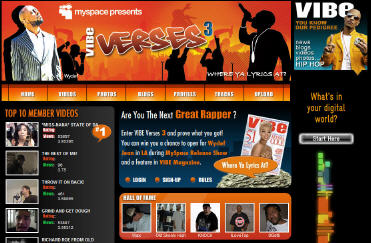
In a nutshell here's how the deal works: a major social networking site (MySpace) has partnered with a specialty publisher (VIBE) for a user generated video-dominated contest (VIBE Verses 3) to build a long term user-generated franchise (powered by KickApps), which will be mainly supported by ad sales.
To understand the deal better, I talked to Michael Chin, SVP of Marketing at KickApps earlier this week. For those not aware, VIBE is a major brand for the urban scene and VIBE Verses 3 is the third round of a contest that "challenges aspiring rap artists to upload videos of themselves performing original lyrics over pre-selected music tracks." Basically you can think of it as an "online-only, urban American Idol." All of the video uploads and social networking is powered by KickApps.
What's interesting to me is that MySpace is involved as the main promotional partner, seeking to build out its strength in this key category. As a large general purpose community site, they're partnering with VIBE, a well-known brand in the category, to bring more value to their members. As Josh Brooks at MySpace puts in the release, "VIBE is a pillar in hip hop and this partnership will help solidify MySpace as the place online for established and developing hip hop artists."
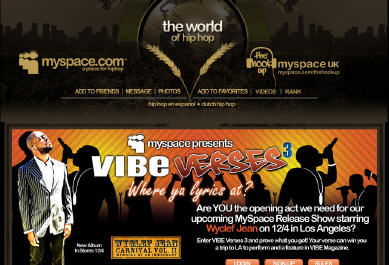
And according to Michael, this was done as a biz dev deal, not an ad sales deal. MySpace and VIBE believe that together they can build a franchise in hip hop that generates longer term value by creating a large, engaged audience of interest to other brands (e.g. Coke, Nike, etc.).
Of course none of this would be possible without broadband - it's the enabler for the user-generated videos that are at the heart of the contest.
In the open broadband video era where direct access to the consumer is ubiquitous, it's going to take more creativity to make deals work for everyone. I think this one is a good example of what can succeed. The deal serves as a template for how other specialty content providers and aggregators/distributors might work together, tapping user participation to build franchises that leverage each party's core skills and assets.
Categories: Aggregators, Brand Marketing, Partnerships, UGC
Topics: KickApps, MySpace, VIBE, VIBE Verses
-
MySpace-VIBE-KickApps Deal May be a Harbinger of What's to Come
Traditional relationships between content providers and powerful aggregators/distributors are being fundamentally challenged broadband video. That's because broadband is an open medium, allowing content providers and brands to enjoy unprecedented direct access to their target audiences. This diminishes a lot of the leverage that aggregators/distributors have traditionally had.
Yet, as I have said for a while, I believe that there's a place for direct-to-consumer and third party distribution/promotion to co-exist harmoniously. But finding good examples has been a challenge. That's why a deal that KickApps announced today with MySpace and VIBE for its "Vibe Verses 3" promotion resonated strongly for me.
In a nutshell here's how the deal works: a major social networking site (MySpace) has partnered with a specialty publisher (VIBE) for a user generated video-dominated contest (VIBE Verses 3) to build a long term user-generated franchise (powered by KickApps), which will be mainly supported by ad sales.
To understand the deal better, I talked to Michael Chin, SVP of Marketing at KickApps earlier this week. For those not aware, VIBE is a major brand for the urban scene and VIBE Verses 3 is the third round of a contest that "challenges aspiring rap artists to upload videos of themselves performing original lyrics over pre-selected music tracks." Basically you can think of it as an "online-only, urban American Idol." All of the video uploads and social networking is powered by KickApps.
What's interesting to me is that MySpace is involved as the main promotional partner, seeking to build out its strength in this key category. As a large general purpose community site, they're partnering with VIBE, a well-known brand in the category, to bring more value to their members. As Josh Brooks at MySpace puts in the release, "VIBE is a pillar in hip hop and this partnership will help solidify MySpace as the place online for established and developing hip hop artists."
And according to Michael, this was done as a biz dev deal, not an ad sales deal. MySpace and VIBE believe that together they can build a franchise in hip hop that generates longer term value by creating a large, engaged audience of interest to other brands (e.g. Coke, Nike, etc.).
Of course none of this would be possible without broadband - it's the enabler for the user-generated videos that are at the heart of the contest.
In the open broadband video era where direct access to the consumer is ubiquitous, it's going to take more creativity to make deals work for everyone. I think this one is a good example of what can succeed. The deal serves as a template for how other specialty content providers and aggregators/distributors might work together, tapping user participation to build franchises that leverage each party's core skills and assets.
Categories: Aggregators, Brand Marketing, Partnerships, UGC
Topics: KickApps, MySpace, VIBE, VIBE Verses
-
UGC Video Ads Becoming More Viable
Announcements from both ScanScout and Digitalsmiths continue to show that ads against UGC video may become more viable. There has been much skepticism about whether the vast trove of UGC video will be monetizable. Concerns about UGC monetization have been partly behind the recent emphasis by traditionally UGC-centric sites like YouTube, Metacafe, Veoh and others to move up the video quality food chain by offering branded or independent video.
Last week ScanScout announced trademark approval for its "Brand Protector" technology which is aimed at
 allowing advertisers to have their messages accompany only content that is deemed appropriate. And today Digitalsmiths (disclaimer: VideoNuze sponsor) has announced "AdSafe", which has the same basic intent and may also functional at a more granular levels of acceptability. Both of these initiatives are should be read as good news in helping the UGC ad market get its footing. Brands looking to harness the power and popularity of UGC video should definitely be investigating these kinds of solutions.
allowing advertisers to have their messages accompany only content that is deemed appropriate. And today Digitalsmiths (disclaimer: VideoNuze sponsor) has announced "AdSafe", which has the same basic intent and may also functional at a more granular levels of acceptability. Both of these initiatives are should be read as good news in helping the UGC ad market get its footing. Brands looking to harness the power and popularity of UGC video should definitely be investigating these kinds of solutions. 
Today Digitalsmiths also introduced "AdIQ", which brings the concept of "conquest ads" to the broadband video advertising world. For those unfamiliar with conquest ads, this is when a brand in the same category as a competitor buys inventory where a competitor is somehow mentioned or identified in the content itself. Here's a pretty good explanation from iMedia.
So for example, say Reebok is mentioned or identified in a video scene and say Nike wants to buy an overlay ad to play at that moment. Conversely, AdIQ allows Nike to ensure that its ad never runs against Reebok (or other competitors') content mentions. This is pretty cool stuff. But how about the media buyer who gets the responsibility to administer all this? I haven't seen the implementation, but I hope Digitalsmiths has made it simple to set up and monitor these campaigns!
Categories: Advertising, Technology, UGC
Topics: Digitalsmiths, ScanScout
-
Magnify.net: A Long Tail Matchmaker
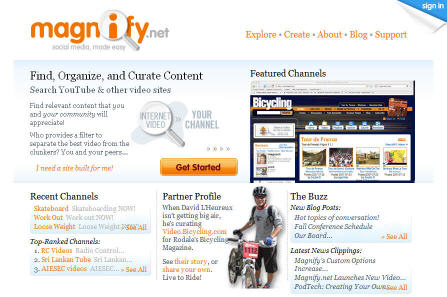 Yesterday I had a chance to catch up with Steve Rosenbaum, CEO and Co-Founder of Magnify.net.
Yesterday I had a chance to catch up with Steve Rosenbaum, CEO and Co-Founder of Magnify.net.One of the things I really enjoy about being an analyst in the burgeoning broadband video industry is getting first-hand exposure to all the clever innovation that's going on. I find it endlessly fascinating to hear directly from entrepreneurs on the front lines where the kernel of their idea came from which led to their business plan. A user experience issue? A technology deficiency? A business model flaw? Over the years I've heard many stories. Some kernels have real weight, while some don't quite resonate for me.
Magnify.net falls into the former category. My read is that this is a company trying to solve a real problem with a very clever solution and the right "corporate attitude" to make it a likely winner.
Magnify is actually solving a number of real problems, many of which relate to the highly distributed or "Long Tail" nature of the Internet and broadband video. First is that while consumers love broadband video, finding what they want is problematic. Novelty quickly turns to frustration when rummaging through big video sharing sites to find something relevant. No matter how much users want choice, some level of editorial or "curation" is essential to optimize their experience.
Magnify enables existing enthusiast or vertical web sites (whether independent or major media) to obtain video from the best video sharing sites (YouTube, Metacafe, etc.) and coherently present a screened assortment to their users. The sites' use their editorial skills to sort the wheat from the chafe, with easy-to-use admin tools ensuring that no offending video slips through the cracks.
So the second problem Magnify solves is enabling thousands (17,500 and counting to be exact) of sites to provide quality video to their users without the hassle and expense of creating it themselves (the "matchmaker" role). These sites get 50% of the revenue from the ads Magnify sells around the video (or they can keep up to 50% of the inventory to sell themselves), leveraging their audience and subject matter expertise. Incorporating video into web sites is becoming online table stakes. I agree with Steve, in the years ahead, sites without video are going to look "charming".
The only real hole I can find in Magnify's model is that it doesn't currently compensate the content creators themselves (a la Revver for example). However I'd expect that to change as creators upload directly to Magnify and the company's network and traffic builds out over time.
Lastly, I like Steve's attitude. He views the market as an incredibly expanding pie, and not "winner take all." As a result, while there are others who touch on Magnify's space (Brightcove, ROO, VideoEgg, Ning, KickApps, etc.), he's less concerned about competition per se and matching feature-for-feature, but rather on responding to the needs and wants expressed directly by their own user base. Companies that do this ultimately win, regardless of competition.
The Magnify story plays into a number of areas I follow closely - the changing role and power of video distributors, the continued "nichification" of video, the challenge of video discovery and the reliance on ads, not subscription fees. To the extent that their approach succeeds it will further morph traditional video models. For a 10 person company that's only done an angel round, they've accomplished a lot in addressing genuine Long Tail issues in the broadband video industry. (Btw, TechCrunch has 2 great reviews, here and here).
Categories: Aggregators, Indie Video, Startups, UGC, Video Sharing
Topics: Brightcove, KickApps, Magnify.net, Ning, ROO, VideoEgg
-
YouTube Gets Serious About Copyright Protection with New Video ID Service
At long last YouTube has launched "Video Identification" in beta, its answer to copyright owners who feel
 YouTube has built its business on the back of their copyrighted content.
YouTube has built its business on the back of their copyrighted content. Having not seen the system in actual use, it's impossible for me to judge how well it works. But having read how YouTube describes its approach in developing the system, considering how it allocates responsibilities for copyright protection with the rights-holders themselves and thinking about the bigger picture challenges all media companies face in the broadband era, my initial reaction is that Video ID is a pretty good first step.
YouTube's approach - As the Video ID page says, YouTube was guided by 3 motivations in creating the system: accurate identification, choice for copyright holders and a great user experience. While there will be plenty of debate about how much emphasis each of these should have received relative to the others, my guess is that the DMCA's requirements and the health of YouTube's business drove the final balance. While YouTube has an image problem with major media which it would like to improve, nobody can expect that the company's SOLE motivation in developing a copyright protection scheme should be the concerns of copyright holders. Whenever I read a copyright holder complaining about YouTube or other piracy issues, I wonder, would these people only be happy if we returned to the pre-Internet age? Since that's not going to happen, less complaining and more adjusting is what's required of media companies now.
Allocating responsibilities - The most controversial part of Video ID will likely be the requirement that copyright holders provide their videos so YouTube can build its database against which to judge alleged pirated copies. The predictable reactions will be "it's too much work", "we don't trust that YouTube won't misuse it and "why should we?". There will be much second guessing whether other technical approaches not requiring submitting full video files would have been as effective. Of course nobody knows for certain, so at the end of the day either you trust that Google, with its pantheon of computer science experts, vetted the options well and selected the best choice, or you don't. It's ludicrous for lawyers and media executives who have never written a line of code in their life to suggest that Alternative A or Alternative B would have been better. I suggest that for now media companies give YouTube the benefit of the doubt. It is incumbent on YouTube to show it will be responsible with these video files and that having them really does make the Video ID system work well.
Bigger picture challenges - YouTube isn't going away, nor are the other video sharing sites. Broadband isn't going away either. And lastly, consumer behavior isn't going to change back what it was in the pre-Internet era. Media companies need to accept that the world is what it is, and learn to adapt themselves to it to succeed. My sense is that Video ID gives media companies all the options they should desire or expect: having the offending content removed, having it continue to run as promotional fodder, or making money off it through a revenue split (though these percentages are TBD). These tools, if they actually work, will give media companies lots of new flexibility to exploit their content with by far the largest audience of broadband video users. If media companies choose not to participate, shame on them for sticking their heads in the sand and wishing the world would return to a simpler time. YouTube has demonstrated for all of us what I believe and have said many times: that broadband is the single most disruptive influence on the traditional video industry. Companies that don't recognize this and don't work with the YouTubes of the world to adapt themselves will ultimately be rendered irrelevant or worse.
Categories: UGC, Video Search
-
Brand Marketers Jumping on Broadband Video Bandwagon
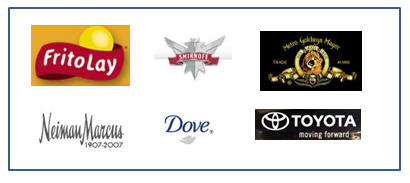
Question: What do Frito-Lay, Unilever, Neiman Marcus, Heinz, Toyota, Smirnoff and MGM have in common?
Answer: In just the last month each of these companies has announced plans to launch some type of broadband video marketing program. Beginning of a trend? You betcha.
Premier brands from one industry to another are recognizing the importance of using video to reach out to and engage better with their customers. Yet I read with interest this piece in yesterday'sWSJ, discussing a big marketers' conference that sold out for the first time ever this year. Adapting to the digital world is a top concern. A Booz Allen survey found that most marketers allocate only 5-10% of their ad budgets to digital media, while online usage continues to soar.
So kudos to the companies mentioned above and the others which are taking their first steps into the broadband world, trying to figure out what tactics work in this new era. Their efforts are varied and reflect the sense of experimentation pervading the market. Consider - Frito, Heinz and MGM are all using some type of content to incent UGC activity. Unilever's Dove soap and Smirnoff are posting original video on YouTube, trying to catch a viral wave. Meanwhile Toyota has devised a new Xbox game called "Yaris" after one of its cars.
As the Super Bowl season approaches, we can expect a lot more broadband video activity from the marketers. Almost 2 years ago I wrote, "The $10 Million Super Bowl Ad". It's worth a peek, I think we're heading in that direction as marketers realize how broadband tie-ins can breathe huge additional life into 30 second Super Bowl spots.
Categories: Brand Marketing, UGC
Topics: Frito-Lay, Heinz, MGM, Neiman Marcus, Smirnoff, Toyota, Unilever
-
MGM's "Lions for Lambs" Google/YouTube Promotion Continues Studios' UGC Efforts
MGM is the latest studio to reach out to fans to help promote one of its films, the upcoming "Lions for Lambs". In a deal with Google/YouTube, the studio is sponsoring a contest in which users can submit a 90 second video on a topic they're passionate about. Entries are being accepted until Oct. 17th and the winner, who will have $25,000 donated to a charity of his/her choice, will be selected on Nov 9th.
This promotion follows the mashup competition Metacafe and Universal conducted this past summer around the studio's "Bourne Ultimatum" release. At the time, I noted that broadband is introducing a whole new element into the film marketing equation, opening up huge opportunities for creativity and fan involvement. As the tools continue to improve I expect we're going to see a lot more of these "UGC-assisted" campaigns.
Studios (and others) are going to continue to experiment with just how much fans are willing to be a part of the marketing machinery. Of course nobody knows, but my guess is that if the incentives are right, the promotions are fun and the stars are compelling, it's going to be a pretty rich vein for film marketers to tap into.
Categories: Brand Marketing, FIlms, Partnerships, UGC
Topics: Google, Lions for Lambs, MGM, YouTube
